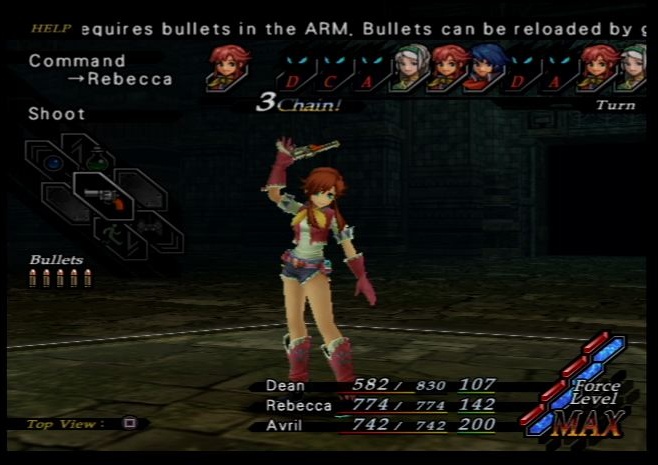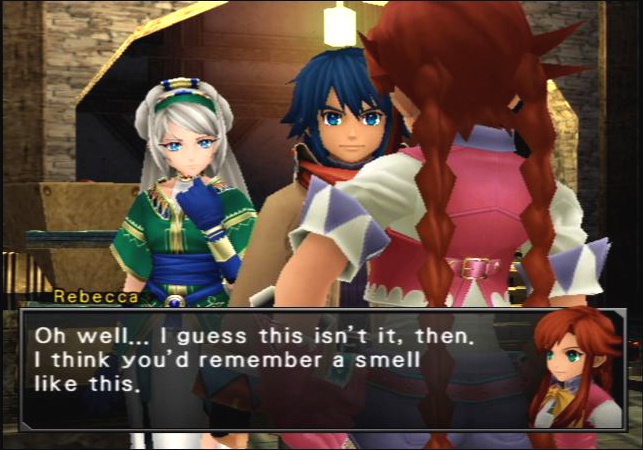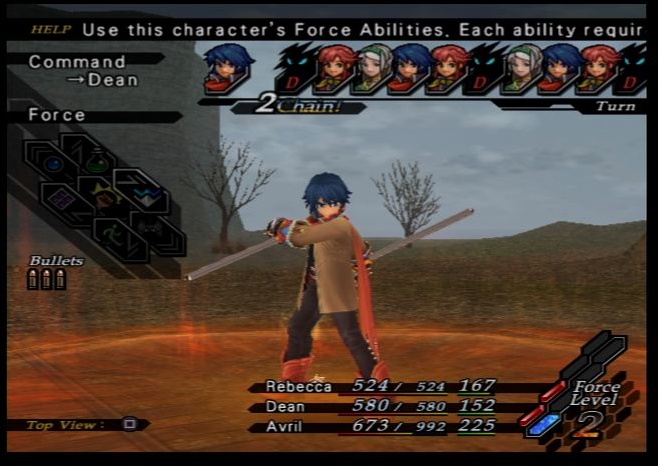"Butter my butt and call me a biscuit," says a character in XSEED's new Wild ARMs 5. Well, calling him a character is a bit of a stretch--he's really one of the immobile town dwellers you see in every RPG who delivers a single line and nothing else, the gaming equivalent of a Hollywood extra. But in a way, that makes him emblematic of Wild ARMs 5--a game like every other Japanese RPG this side of Final Fantasy, with a few extremely weird differences.
Wild ARMs, in case you're new to the series, is composed mostly of traditional role-playing games in which a main character and friends battle a great evil to save the environment, while learning to share, keep promises, and generally come of age. The series' two trademarks are the hex battle system (a simple tactical battle grid) and ARMS, aka guns. In practice, these guns are just like the weapons from any other series. For example, the main character in Wild ARMs 5 uses his twin pistols like tonfa, hitting enemies with them rather than shooting them.

The story takes place in the Western-themed world of Filgaia (can't you tell by the name?), where a teenager named Dean and his best friend Rebecca discover a giant, severed robot arm with an amnesiac girl named Avril in its palm. Avril remembers only two words, "Johnny Appleseed," and is clutching two pistols, which she gives to Dean. And so the three embark on a globe-trotting, gunslinging adventure to learn about the fabled folk hero, the meaning of perseverance, and the incredible economic iniquities spawned by technological power, not to mention its socioecological ramifications. Well, butter my butt...
Though Wild ARMs 5 starts shallower than most (Barney and Friends comes readily to mind in the early going), the themes it raises later have real-world roots. Indeed, older players will recognize references to the Berlin Wall and be surprised by a succinct, coherent explanation of political schadenfreude. But in true adolescent form, the game oversimplifies its adult themes. In one conversation, for instance, a wicked concentration camp boss who has slaughtered hundreds if not thousands of people repents his wicked ways and is completely forgiven by the party, who knew he was a hero all along. He just had the wrong attitude...about genocide.
The same clumsiness that causes Wild ARMs 5 to fumble big ideas yields strange but delectable fruit elsewhere. For example, in the same game, there are characters named Avril, Rebecca Streisand, and Elvis (for a pop-cultural hat trick) as well as characters named Duogrammaton and Fereydoon. And then there are talking-bird save points, each of which wants to discuss a deadly sin. Or, as one bird puts it: "Well now, you're one handsome looking fellow. You here to take a dip with me into the sea of lust? Or do you want to save?" Horny talking-avian save points, Batman!
So Wild ARMs 5 is pretty weird and tells an interesting, if out-of-control story. Even better, its pace is brisk, so you'll never go more than a half hour without some new piece of narrative gristle to chew on. This is very important, because the game follows your usual town-dungeon-town-dungeon flow. You go somewhere, someone tells you to get something from a dungeon, you enter said dungeon, battle through a hundred random encounters, kill bosses, get item, return to town, buy better weapons, move to next town. It's the E=MC² of RPGs.
Wild ARMs 5 deviates from this formula in subtle but important ways. For one thing, each dungeon generally has three or four bosses, not one. And each contains a statue known as a Sol Niger, which when cleansed allows you to turn on or off random encounters. Each door is marked by whether it's been entered, recently exited, or used (but not recently) for navigational purposes. And every save point, including those horny little birds, will provide a hint as to where you're supposed to go next. How convenient!
Your guns also come into play in the dungeons, where you can shoot treasure chests and pots to open or break them. The guns are also worked into the game's environmental puzzles, some good some bad, and you eventually accrue seven different kinds of bullets to help you make your way through rooms full of switches, boxes, buttons, and torches.
The battle system uses a small grid with one space in the middle, and six surrounding it. Three of the outlying spaces have an elemental property (spells cast from them assume that element), and figuring out your enemy's weakness then capturing the space that can exploit it is the name of the game--or at least, the boss fight. It's a pretty deep system, but the overall effect is that random encounters are more dynamic than usual (though no less frustrating), and boss fights play out like chess matches. Except that while you play chess, the enemy plays checkers, routinely making unaccountably stupid choices. If you miraculously lose to its Fisher Price artificial intelligence, you can elect to start the battle over, or return to your last save point. This is also very convenient.
Like the Hex system, character development is a blend of the intuitive and the arcane. There are items called mediums, which are essentially equippable classes. They have names like sea, sky, mountain, and sword (so much for consistency), but they boil down to normal RPG roles--blaster, tank, thief, healer, and so on. However, when you equip one of these, based on your level, you can allocate points to combat, magic, or special meter regeneration. (By the way, your party has a special meter that fills during combat, which lets each characters use class-based special moves as well as multiple-character team attacks.) You can switch all of this at any time, and while some characters are better fighters or casters, the point is, it's a simple class system with an underlying level of customizable detail. You can set it and forget it, or nerd out with micromanagement--the choice is happily yours.
That sounds good, but it doesn't look good. From the field, to the fights, to the menus, Wild ARMs 5 looks like a much worse game than it is. The artistic style is bush-league anime. The big eyes, crazy hair, and skimpy clothes are there, but nowhere are the signature touches of a professional artist. The hex system is an eyesore, and the menus are full of acronyms, numbers, and weird meters, all of which have substance, but zero style. And then there's the game engine. You don't fully realize how broken this is until you gain a one-wheeled motorcycle to, in theory, quickly traverse terrain. In practice, it's like having a seizure in a bumper car. Invisible walls abound, and the wheel is governed by truly fantastical laws of physics. Still, it beats all the random battles.
But what would a Wild ARMs game be without horrible, repeating sound bites? Rather than assault you with the full, telephone-book-size list, allow us to reveal the most offensive instance of audio gone awry: ladder climbing. That's right, when you climb a ladder, the game's sound files go berserk and fire off like a string of firecrackers. Within two rungs, your character will grunt, shout "Yeah!," grunt again, and yell "Here we go!" while simultaneously cheering. The music, on the other hand, is outstanding. There is a solid steel-string guitar track, another one that features flutes, and, of all things, a whistled travel tune.
Wild ARMs 5 is a tripolar blend of the good, the bad, and the ugly, but most importantly, it's odd enough to distinguish itself from other RPGs, and well-designed enough for you to enjoy playing. While its wacky foibles stretch a little thin after hour 25 (the game takes roughly 30 to beat), this teriyaki Western is worth checking out, especially if you can get it at a bargain or rental price.

